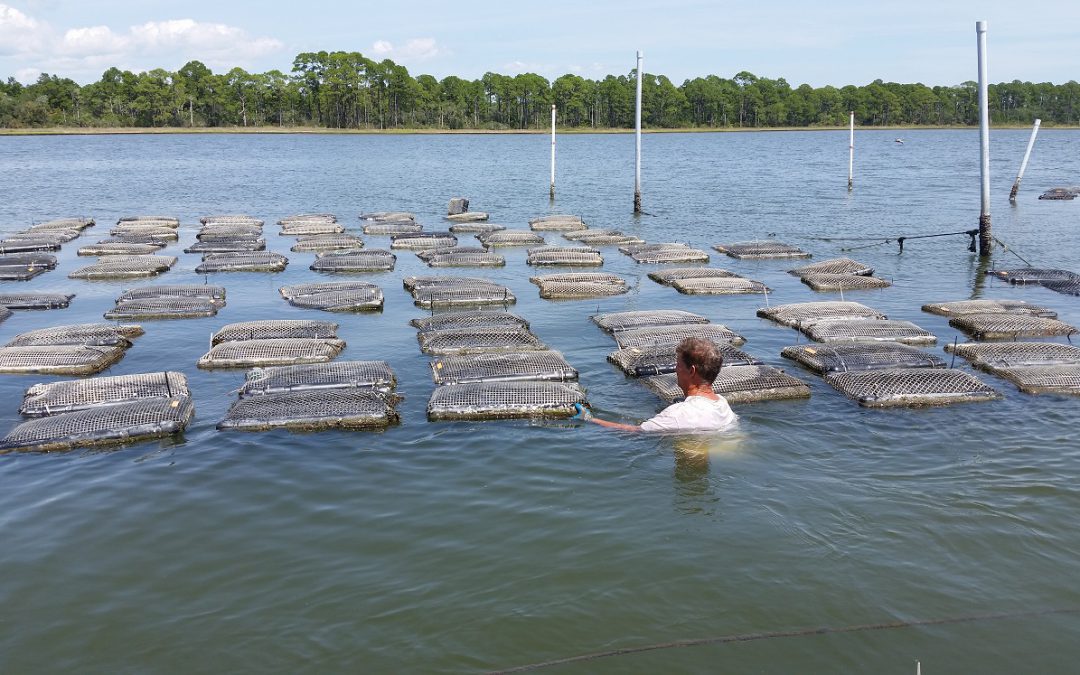
by Erik Lovestrand | Sep 25, 2020
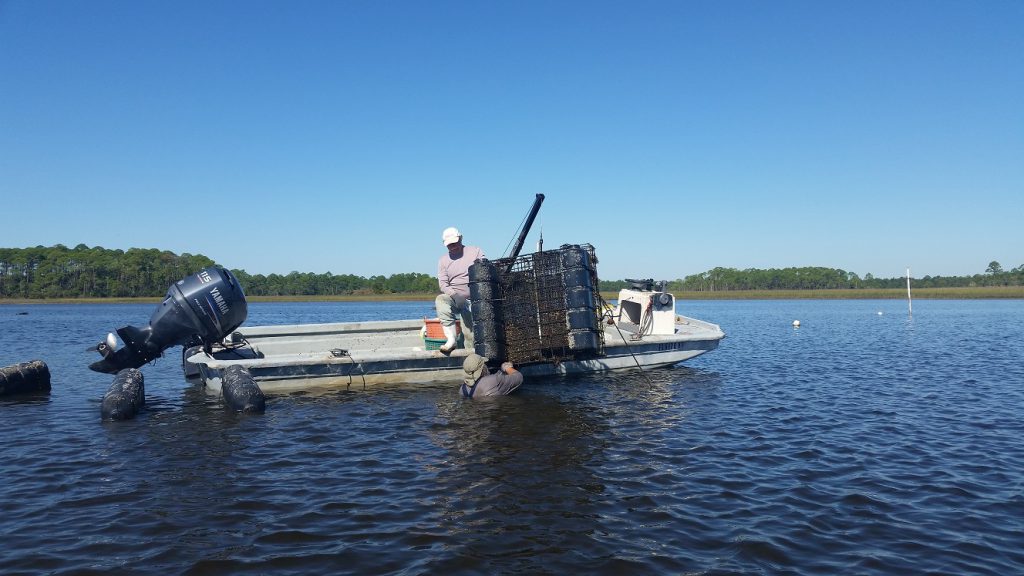
Hard work and perseverance are a must for oyster farmers.
On September 17, 2020, President Trump and US Secretary of Agriculture, Sonny Perdue, announced a second phase of an important program assisting America’s farmers. The Coronavirus Food Assistance Program (CFAP 1) was originally announced in April 2020 and now CFAP 2 will provide up to an additional $40 billion in support, along with adding more than 40 specialty crops not previously covered under CFAP 1.
This will be welcome news for many Panhandle farmers; particularly the ones that conduct their “chores” in our Panhandle bays and bayous by producing aquacultured oysters and clams. Losses in sales of molluscan shellfish were not covered under CFAP 1 because they were eligible for some assistance under the CARES Act (Coronavirus Aid, Relief, and Economic Security). However, many local growers were not able to qualify under the CARES Act for various reasons and are in serious need of assistance. When restaurants and bars were forced to close during the pandemic, sales of fresh oysters and clams basically came to a standstill overnight. Many creative efforts at direct marketing to customers and other avenues to move these time-sensitive products have been undertaken but sales are still far from what they were in 2019, leaving many growers with bills to pay and a significantly reduced bottom line.
Applications for CFAP 2 will be accepted by the USDA from September 21 through December 11, 2020. Payments will be based on 2019 sales, excepting new farmers who had no sales in 2019. Their calculations will be based on 2020 sales up to the point of application. The percent-payment-factor will be figured on a sliding scale, depending on amount of sales; ranging from 10.6% for sales below $50,000 to 8.8% for sales over $1 million.
The USDA has done a very good job of laying out information regarding the program on their website (here) and also provide assistance through their local Farm Service Agency offices around the state. Assistance with applications is available on line at this link. Two of the counties that have a significant and growing oyster aquaculture industry in the mid-Panhandle are Wakulla and Franklin. The FSA office for Wakulla County is in Monticello and can be called at (850) 997-2072 ext 2, or email Melissa Rodgers at melissa.rodgers@usda.gov. Growers in Franklin County can reach their FSA office in Blountstown at (850) 674-8388 ext 2, or email Brent Reitmeier at brent.reitmeier@usda.gov.
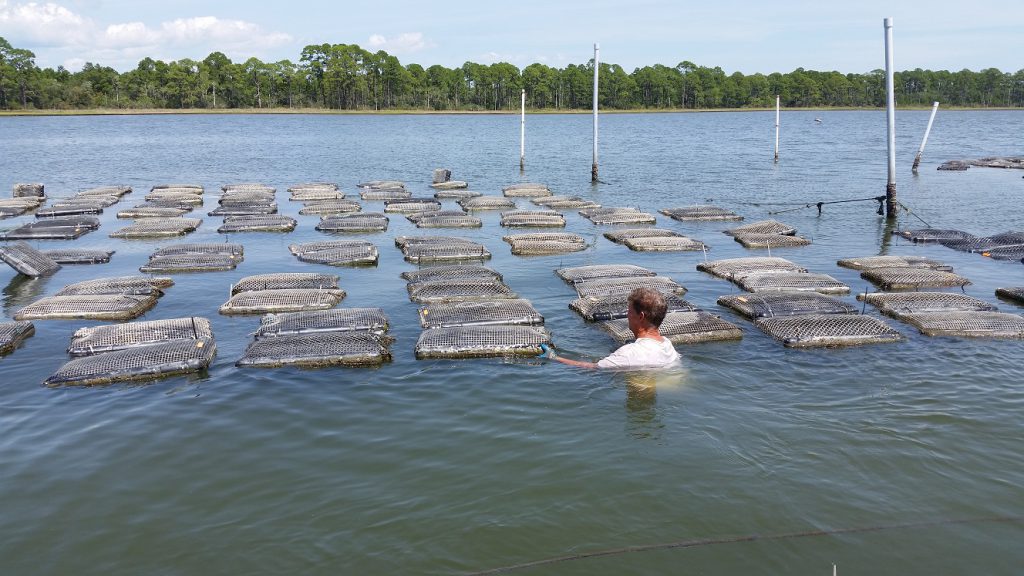
Growing oysters in floating bags requires getting wet, alot
With the plethora of confusing acronyms flying around in our present day, CFAP is one worth paying attention to. Why? Because it is providing targeted assistance to a segment of our US economy we should all stand behind. Agriculture is a critical component of all of our lives each and every day. If you have a chance to thank a farmer for what they do, or a legislator for moving this effort forward, or an industry support group that provided the data the legislator needed; don’t miss the opportunity. The hard-working men and woman who produce our food supply, including great, locally grown fresh seafood, deserve it.
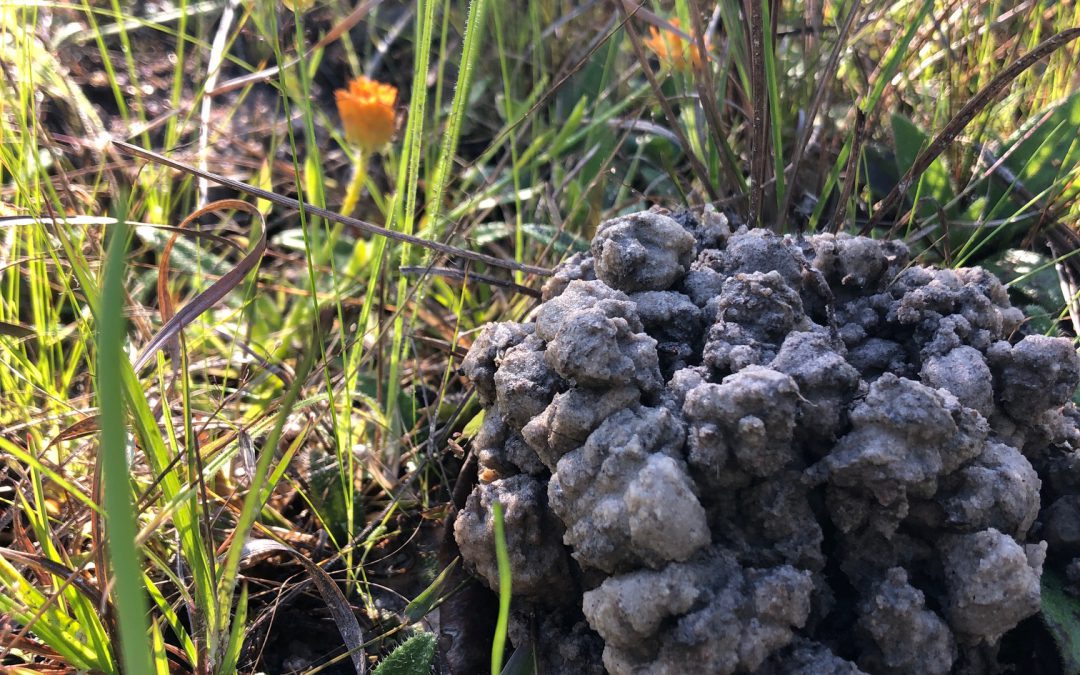
by Carrie Stevenson | May 15, 2020
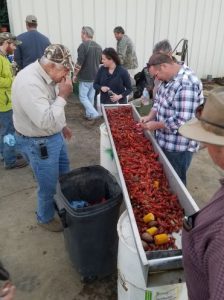
Crawfish boils are popular in the springtime. Crawfish are generally harvested from aquaculture operations. Photo credit: Libbie Johnson, UF IFAS Extension
“You get a line, I’ll get a pole, we’ll go down to the crawdad hole, honey, baby, mine“…there are lots of great zydeco songs singing the praises of crawfish (aka crayfish, crawdads, mudbugs). They are in season now, and while crawfish festivals all around the southeast are canceled due to concerns over COVID-19, they are still available and make for great eating. Most of us would recognize a cooked one alongside a feast of corn and potatoes, but would you know an actual crawfish hole if you came up on it?
Last fall, our office welcomed about 500 kids (over several days) to the 4-H camp in Barrineau Park for a field trip. I showed every single one of them a small muddy mound with an opening in the top, and asked if anyone could tell me what it was. Not a single kid knew! Now, I make sure I point crawfish mounds out to anyone I happen to be walking with, as they are fascinating little structures. Also referred to as crawfish chimneys due to their upright, open construction, they are built by a crawfish in a muddy area, often near a creek or other water source.
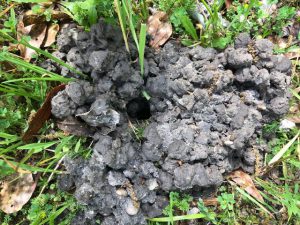
Crawfish mounds are constructed using small pellets of mud, and the opening connects down to a burrow. Photo credit: Carrie Stevenson, UF IFAS Extension
The industrious invertebrate uses its legs and mouth to create pellets of mud as it digs its burrow. It places mud up above the ground, using the mud balls like small bricks. Bricking up the entrance to its burrow (as opposed to placing discarded mud elsewhere) also protects a crawfish from exposure to predators on open soil. The crawfish chimneys can be 6 inches tall (or more!) and connect down to a burrow that may reach 3 feet deep, some straight down and others with side tunnels extending different directions.
Since the crawfish lives in wetland areas, it is theorized that these chimneys extending above the soil allow for better oxygen flow in the burrow. During a drought, crawfish will plug the opening of their mounds with mud, to keep water in the burrow from evaporating.
Crawfish in the wild are rarely harvested, although some folks do fish for them like the song referenced earlier. For the vast majority of crawfish harvested in commercial production, two species are the most popular–the white river crawfish (Procambarus zonangulus) and red swamp crawfish (Procambarus clarkii). They are typically farmed in coordination with rice, as both commodities thrive in flooded conditions. Most aquaculture operations are associated with Louisiana, but at least five other southern U.S. states farm crawfish. To learn more about this industry, check out LSU AgCenter’s informative video.
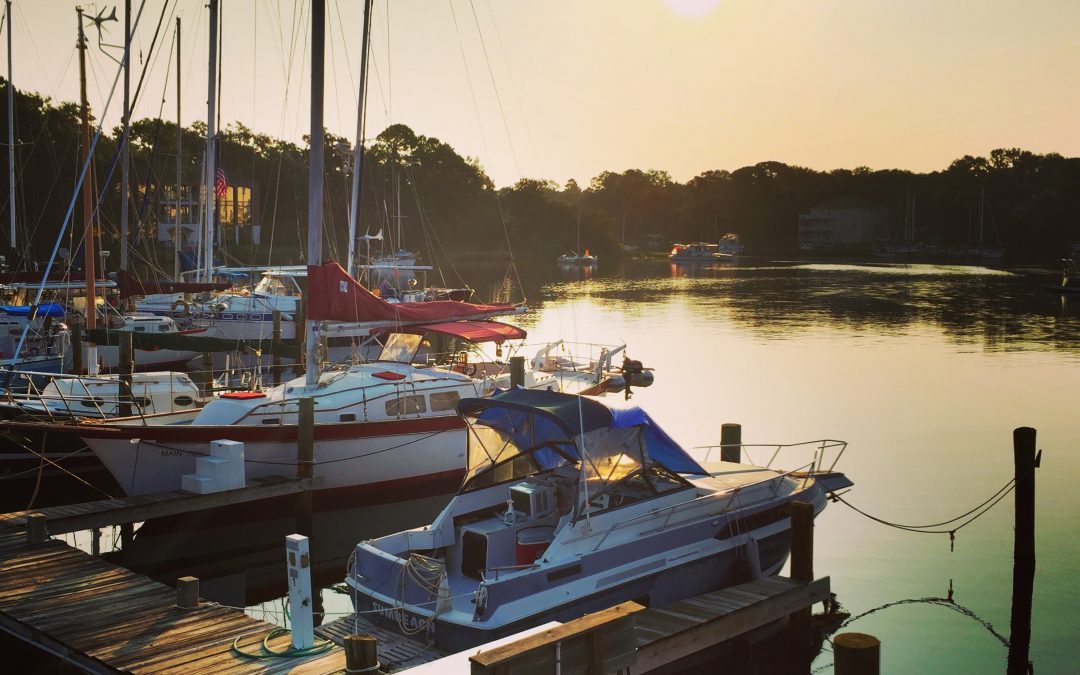
by Scott Jackson | Apr 17, 2020
Florida Sea Grant is maintaining a curated list of disaster assistance options for Florida’s coastal businesses disrupted by COVID-19.
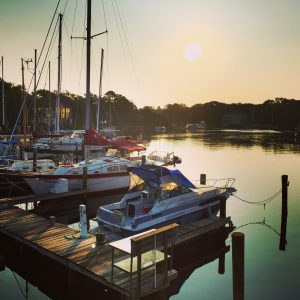
Boats at calmly at rest in Massalina Bayou, Bay County, Florida.
The list contains links to details about well- and lesser-known options and includes “quick takeaway” overviews of each assistance program. Well-funded and widely available programs are prioritized on the list. The page also houses a collection of links to additional useful resources, including materials in Spanish.
“There is a lot of information floating around out there,” says Andrew Ropicki, Florida Sea Grant natural resources economist and one of the project leaders. “We are trying to provide a timely and accurate collection of resources that will be useful for Florida coastal businesses.”
Ropicki and others on the project team stress that the best place to start an application for disaster aid is to visit with your bank or lender and the Florida Small Business Development Center (SBDC). They also suggest contacting local representatives by telephone or email and not to just rely on internet-based applications.
Overview of Selected Disaster Assistance Programs Benefiting Florida Small Businesses including Agriculture, Aquaculture, and Fisheries (COVID-19)
The project team — which includes experts from Florida Sea Grant, University of Florida Institute of Food and Agricultural Sciences (UF/IFAS) Extension, and the UF/IFAS Center for Public Issues Education — reviews the page regularly for accuracy and to include new options.
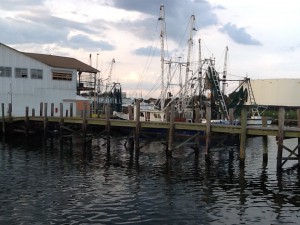
Commercial seafood is a large part of Florida’s economy and culture.
Photo: Rick O’Connor
“[I] really appreciate the outstanding work that you and FSG have done on consolidating the various types of aid available to fishermen due to the virus,” said Bill Kelly, executive director of the Florida Keys Commercial Fishermen’s Association, in a recent email. “I’ve been searching for a comprehensive listing and you just provided it.”
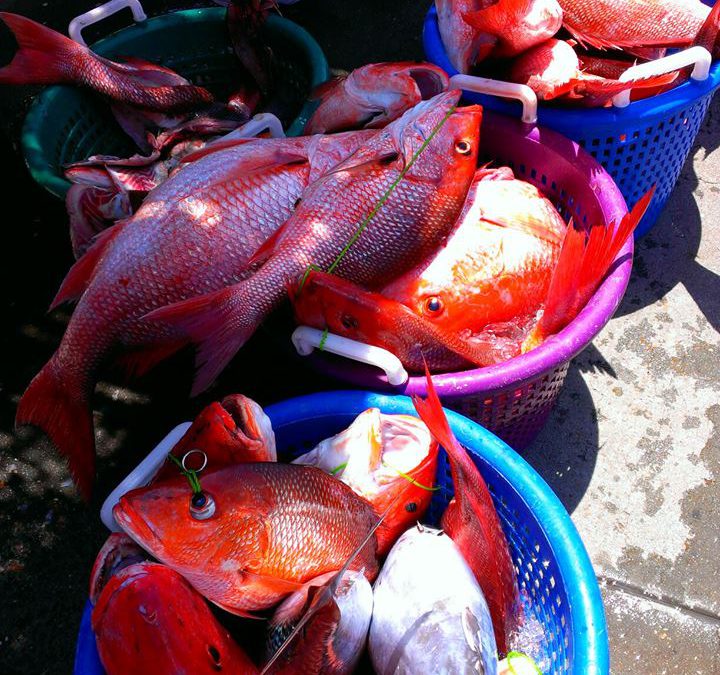
by Rick O'Connor | Mar 20, 2019
I recently had the fortunate opportunity to observe a commercial longline vessel being unloaded at a landing near Perdido Key. 10,000 pounds of fish, mostly grouper and tilefish, were being unloaded for markets in Atlanta, Canada, and locally. When I heard 10,000 pounds two things popped into my head right way…
1) That is a lot of fish
2) It is great to know that fresh local seafood can still be had.
It is a lot of fish, and this concerns some about the future of wild caught seafood. Humans have been harvesting wild caught seafood since the beginning of time, or at least as far back as boats go. What has changed today is better technology and more fishermen on the water. With these issues in mind, you have to either (a) reduce the number of fishermen on the sea, or (b) reduce the number of fish harvested. Though not always popular, this is where fisheries management comes in.

Commercial seafood is a large part of Florida’s economy and culture.
Photo: Rick O’Connor
The basic idea is to allow each species a chance to breed at least once before they are harvested. The Magnuson-Stevens Act, passed in 1996, requires that commercial fisheries within U.S. territorial waters be sustainable – meaning viable into perpetuity. To do this you need to know the life cycles of your target species. At what age do they become sexually mature and begin breeding? The age of a fish can be determined by rings in the otolith (ear bone) and there is a correlation between the number of rings and the length of the fish; hence the length regulations many species have. You need to know at what age they reach maturity, you allow one (sometimes more) years beyond this age allowing them to breed.
The next metric is how many of the mature adults can you allow to be harvested and remain sustainable. This obviously takes a lot of fisheries biology, and there are researchers at the federal, state, and university levels who work on these questions. When you know the answer to some of the biology questions, you can now input this into a computer model and determine what is known as the maximum sustainable yield, or how many fish (or the number of pounds) can be removed and still be sustainable.
Computer models are only as good as the programs that are developed for them. These can be hard to test. Hurricane computer models have become pretty good. Everyone remembers when Michael was approaching the Pensacola area and the modelers were sure it would make an eastward turn; and it eventually did. The thing about hurricane models is that if they are not working well, you know relatively quickly. Hurricane approaches shore – computer predicts where it will go – it makes landfall somewhere else – you correct the model – we get better. With fisheries, and other issues, we do not always get feedback as quickly as this. Stock assessments for selected species have to be made to see how the models are working, and this takes time.
Though it may not be an exact science, fisheries management certainly has helped hold on to some species that would have been harvested out otherwise.
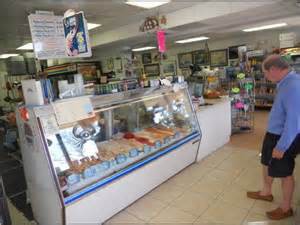
There are about 80 species of commercial seafood products that come from Florida.
Photo: Florida Sea Grant
As far as knowing local seafood is still available, this is good news for many. Checking in with your local seafood markets you can find a variety of species at different times of the year. Some provide information as to which local restaurants they sell to. Many locals, and visitors, are willing to pay a higher price for these sought-after seafood species. It is good to know you can still get them in our area.
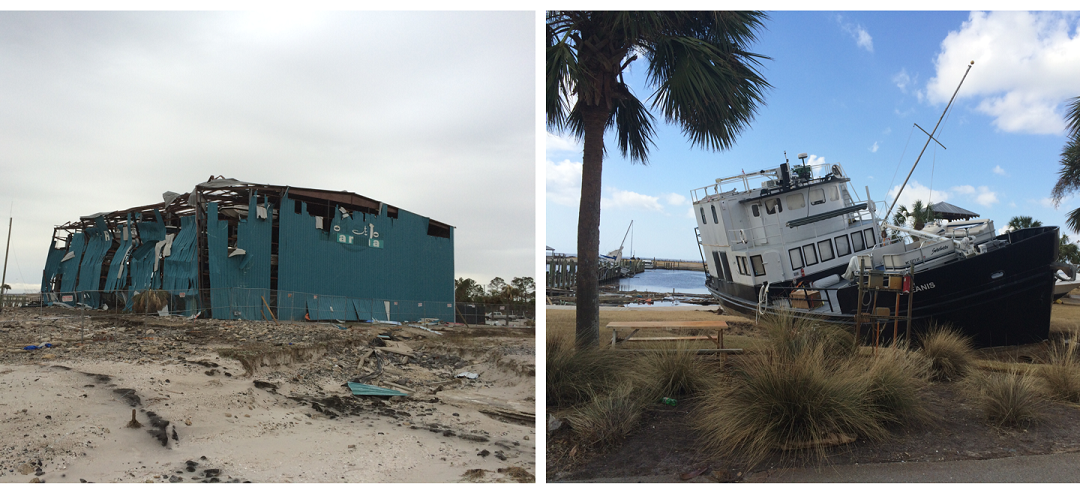
by Erik Lovestrand | Nov 26, 2018
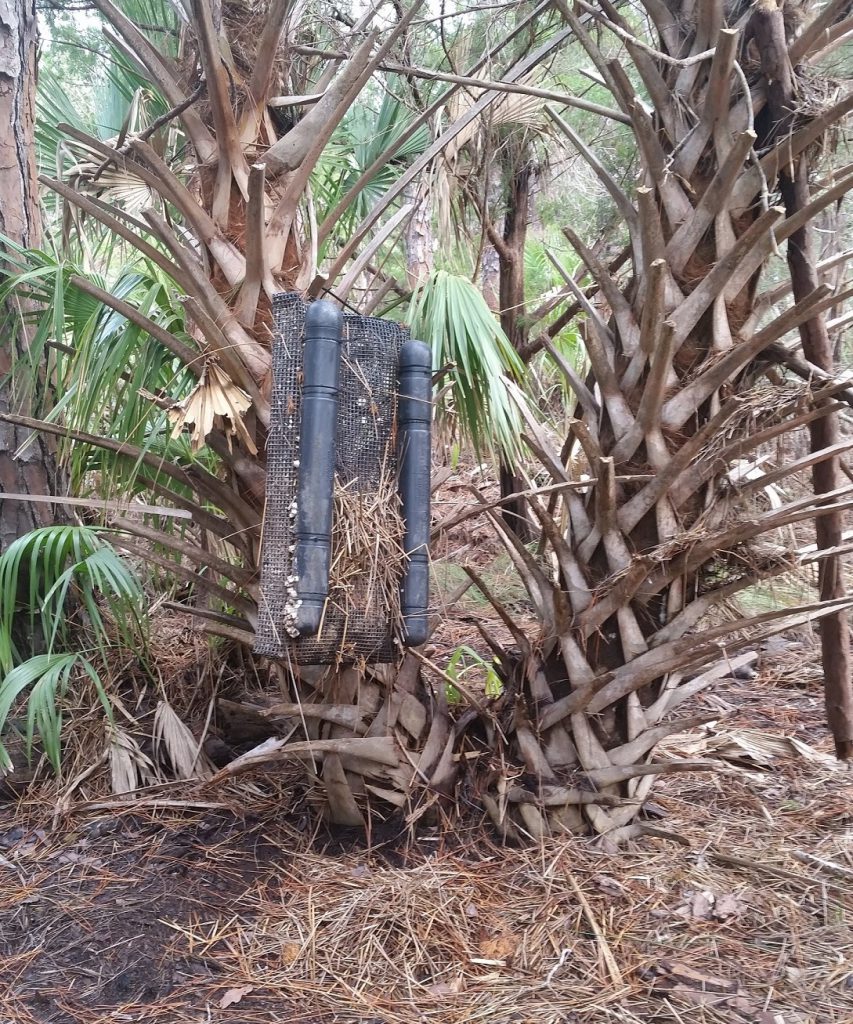
Oyster grow bag left hanging by Michael’s storm surge.
Erik Lovestrand, UF/IFAS Franklin County Extension
It may be a long time before the memories of Hurricane Michael begin to fade in the mind’s eye for residents of the Florida Panhandle. A record-breaking tropical cyclone in many respects, Michael caught a lot of people in the region off guard as it continued to gain strength on its rapid path through the Northern Gulf of Mexico. When many people went to bed the night before landfall, they had no idea what terrifying news would greet them upon hearing that a still-strengthening category 4 hurricane was about to rumble ashore.
It was not long after the wind slackened that folks began looking around and realizing the devastation left behind. Cotton crops in the path of the storm in North Florida and South Georgia suffered near 100% losses. Peanut crops were also severely impacted just at the time that harvest was beginning. The estimated damage to timber harvests alone were coming in around 1.3 billion dollars for Florida as virtually entire forests had been leveled. Even more damage was realized near the coastline where storm surge across the region ranged from 8 to 14 feet above normal water levels; smashing or flooding structures near the coast and carving new inlets across St. Joseph Peninsula near Cape San Blas.
Another industry that took a hard hit in much of the area was the seafood industry; everything from the producers to the dealers, processors, retail markets, restaurants, fueling and ice house facilities that service fishing vessels. Governor Scott requested a fisheries disaster declaration from the Federal Government and on November 1 the Secretary of the Department of Commerce granted the request. This determination provides an opportunity for Congress to appropriate fishery disaster assistance for the new fiscal year, which began in October. To further facilitate recovery efforts in Florida and beyond, the Department of Commerce can look to the Economic Development Administration, which spearheads the Federal government’s efforts to deliver economic assistance and support long-term growth after natural disasters.
Oyster growers in the region who had equipment and a crop of shellfish in the water took some losses as well. For those who were able to scramble to their leases before the storm and sink their floating baskets or cages to the bay bottoms, losses of gear were minimal as storm waves above the submerged gear had less impact. Gear that was unable to be submerged was more prone to break loose and drift away. However, even the growers that sunk gear experienced some significant oyster mortality due to sediments from churned up water smothering the shellfish in a layer of mud. Shellfish leases in Alligator Harbor were dealt another blow by an incredible field of debris that was washed off Alligator Point and blown through the lease area. Everything from boats to large sections of docks, structural walls, refrigerators and freezers was in the mix. These items were caught up in oyster long-lines and broke some while pulling up anchor poles on others, leaving quite a mess for growers to untangle.
Marinas, docks and vessels were also not immune to Hurricane Michael’s wrath in Gulf and Bay Counties. Government agencies estimate the number of damaged vessels in both Gulf and Bay counties to exceed 400. It will take some time for charter boat and commercial fishing operations to rebound. Scallop restoration projects in both St. Joseph Bay and St. Andrews Bay have suffered setbacks, as well. The hurricane has not only devastated coastal Gulf county economically and ecologically, but also geographically. There are two sizable inlets that have now been carved into the St. Joseph Peninsula. T.H. Stone State Park is closed until further notice.
Overall, the impacts from this storm will take a long time to recover from for many segments of our regional economy. Lessons learned by industries as well as individuals should improve our chances to reduce the loss of life and property in the future. The name of the game is “resiliency,” both in the spirit of the people who call this place home and in the way we learn to better adapt to what Mother Nature throws at us. Hang in there. Day by day.
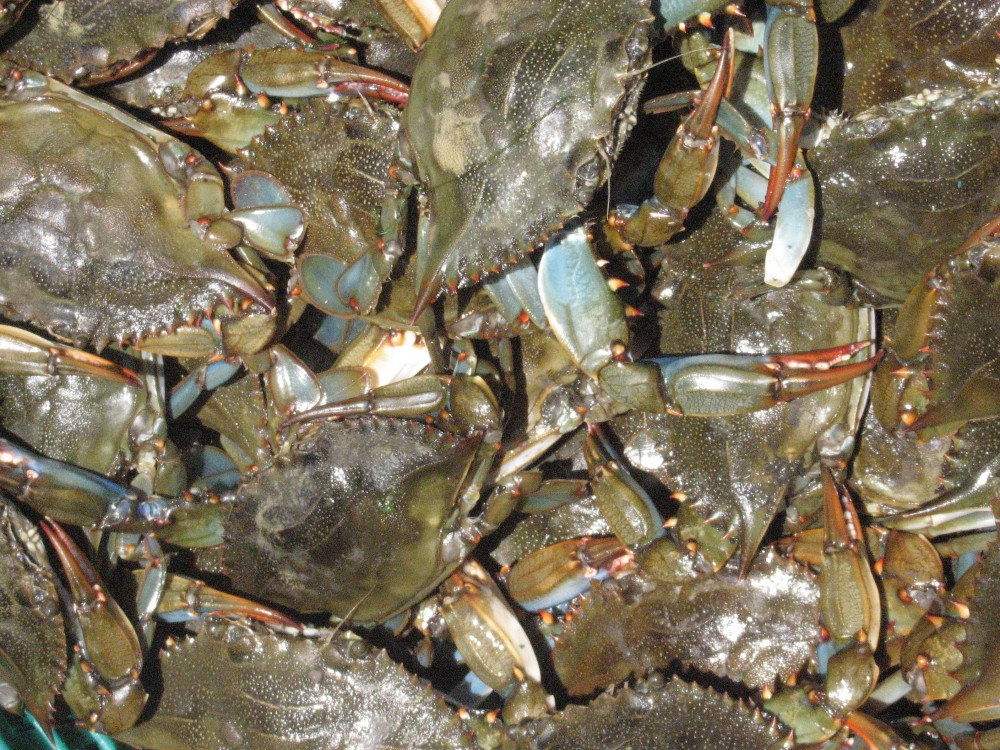
by Rick O'Connor | Sep 2, 2018
Most kids who grew up on the Gulf Coast grew up catching blue crabs. These animals are common along our shorelines, relatively easy to catch, and adventurous because they may bite you. I caught my first one in 1965 and we proudly displayed the boiled shell over the kitchen bar for many years. This is also a popular seafood target with an estimated commercial landing value of $56,950 in the Pensacola Bay area in 2017.
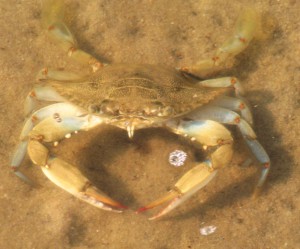
Blue crabs are one of the few crabs with swimming appendages.
Photo: Molly O’Connor
But who is this crab that we enjoy so much? What do we know about it?
As you probably already know, it is one of an estimated 30,000 species of arthropods we call crustaceans. Crustaceans differ from insects and arachnids in that they have five pairs of legs and two sets of antenna. Insects typically have a head, thorax, and abdomen – however, in the crustaceans the head and thorax are fused into what is called a cephlathorax and covered with a section of the shell called the carapace. Like all arthropods, their body are completely covered in a chitinous shell that serves as their exoskeleton. This exoskeleton must be periodically shed (molting) so they can continue to grow. Crustaceans tend to molt about 10-11 times each year and typically in the summer months. To molt, crustaceans will remove some of the salts and minerals from the shell into their tissue, this weakens the shell enough to separate it. The crack is usually between the cephlathorax and abdomen. When they emerge, they are completely soft and about 30% larger than before – it is amazing to see this large crab emerge from the small shell it once lived in. Because of the softness of the body after molting, this is usually done under the cover of darkness for protection. The salts and minerals it removed during pre-molting are now used to harden the new shell – which can take a couple of days. It is at this stage we call them “soft shells”.
The crustaceans include many different kinds of arthropods – most notably are the crabs, shrimps, and lobsters. There are over 4500 species of crabs and they differ from shrimps and lobsters in the fact their abdomen flexes beneath their body – you do not see the “tail” you see in a lobster or shrimp – but its there. Crabs can also move very well laterally, which their cousins are not so good. Blue crabs differ from other crabs in that their last pair of legs are modified as paddles and the animal can swim. They can swim forwards, backwards, and laterally – and they are often seen swimming at the surface. There are other crabs who have these swimming paddles and they are all called protunid crabs.
Blue crabs perceive their world through their eyes, antenna, and sensory cells on their body. They are very good at burying in the sand – eyes and antenna exposed – and sensory cells all working – seeking prey and avoiding predators. Their eyes differ from ours in that they have numerous lenses, compared to our single one, and are called compound eyes. Each lens does not provide them with an image of you or me however. Rather each lenses provides them with a single pixel of light. It is much like the image you see on television when they are trying to block out a brand name, or someone’s face. The more pixels (lenses) you have, the clearer the image. Those this type of eye does not give as clear an image as ours; it is very good at detecting motion and has served the arthropods very well over the years.
For blue crabs, food can be just about anything. They are active hunters – usually using the ambush method of capture (buried in the sand), but are also known scavengers – eating any bits of food they can find. Those enjoy crabbing know this – you can put just about anything as bait in a crab trap and it works. They have numerous predators including fish, birds, mammals, and sea turtles.
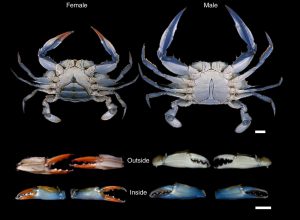
Male and female blue crabs.
Photo:
Blue crabs can be found in a variety of salinities (euryhaline). Males are typically found in the lower salinities of the upper bay. Females join them during mating season – which is in late spring and summer. Males cradle the females beneath his legs for several days waiting for the right location and moment to breed. Fishermen refer to them as “doublers” during this time. The females will molt and the male will then deposit his sperm into a sac called a spermatophore – which he then deposits to the female. She will then migrate to the more saline lower portions of the lower bay, while he remains and seeks another female. This may be the only spermatophore she receives her entire life – which can be up to five years, though most do not live beyond three years. She will use sperm from this spermatophore over that time to fertilize eggs.
The eggs develop in a sponge mass that develops beneath her abdomen. This egg mass is orange when in early development and becomes a darker brown with age as the larvae consume the yolk. There can be between 750,000 and 2,000,000 developing eggs within this mass. The females are called gravid at this stage and it is illegal to harvest gravid crabs in Florida.
The eggs hatch in about two weeks and a small microscopic mosquito looking larvae emerges – at this stage, they are called zoea. The zoea drift into the Gulf of Mexico where they feed and molt. Eventually they return to the estuary and become a microscopic crab with a tail – this stage is called a megalops. The megalops will feed and molt. The tail will eventually flex beneath and the crab becomes sexually mature. The entire process from hatching to sexual maturity is about 12-18 months.
These are fascinating animals. They are very common and a large part of the coastal culture of the Florida panhandle. Kids will have great fun catching them with a hand net, letting them swim in their beach buckets, but be sure to let them go before you head home and watch those claws – they do know how to use them. It is a great animal.
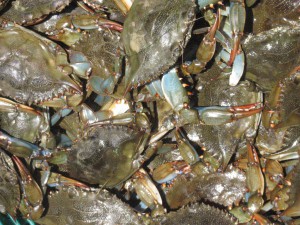
The famous blue crab.
Photo: FWC
Recreational Blue Crab Harvest Regulations in Florida
No size limit
10 gallons whole / harvester / day
Harvesting gravid females is prohibited
Five crab traps / person – cannot be placed in navigation channels
Trap closed season in Florida panhandle – Jan 5-14 in odd years.
References
Barnes, R.D. 1980. Invertebrate Zoology. Saunders College Press. Philadelphia PA. pp. 1089.
Blue Crab. Callinectes sapidus. Chesapeake Bay Program. 2018. https://www.chesapeakebay.net/discover/field-guide/entry/blue_crab.
Florida Fish and Wildlife Conservation Commission. Commercial Landings in Florida. 2017-2018. http://myfwc.com/research/saltwater/fishstats/commercial-fisheries/landings-in-florida/.
Florida Fish and Wildlife Conservation Commission. Recreational Blue Crabbing. http://myfwc.com/fishing/saltwater/recreational/blue-crab/.

















